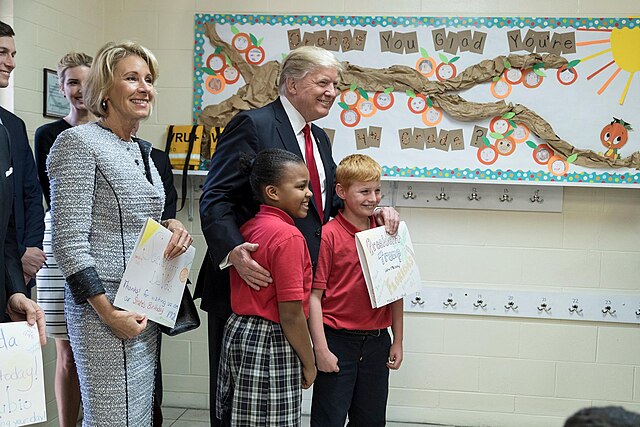
THE MIRROR | Couresty of Wikimedia Commons
Trump administration reshapes education with funding and curriculum cuts
Following President Donald Trump’s second inauguration, students participating in the LAUSD walkout held up signs reading “Our Education, Our Rights,” and chanted, “It’s not just about us now, but about every student after us.”
As Trump’s policies spark protests across the country, students here are questioning how these changes will affect their education and their future. These include proposed education funding cuts, curriculum restrictions and policies targeting transgender student rights.
One of Trump’s primary goals is to reduce the role of the U.S. Department of Education, shifting control to states over education policies and funding, which critics argue could lead to unequal distribution of resources and exacerbate educational disparities.
In addition to funding changes, the Trump administration is targeting school curriculum through executive actions.
A recent executive order cuts funding for programs that include critical race theory, gender studies and other topics the administration deems inappropriate.
Some argue that this prevents political bias in schools, while others contend that it censors important discussions about history and identity.
Students like Junior Allanna Barrios say these restrictions erase valuable learning opportunities.
“Cutting these programs stops us from learning about the world as it really is,” she said. “History and identity matter and we shouldn’t be silenced when it comes to important conversations like these.”
Another key policy targets transgender student rights. A new federal order bans transgender girls from competing in girls’ sports and states that refuse to comply could lose federal education funding, even though sports participation is not directly tied to academics.
Maine’s Department of Education is under federal investigation for allowing transgender girls to compete in girls’ sports — a move the government says may violate Title IX, which prohibits sex-based discrimination in federally-funded education programs. Not complying could cost the state $250 million in school funding.
At Van Nuys High School, students walked out to protest Trump’s immigration policies, highlighting how young people are becoming more involved in political issues that impact their lives.
“I felt it was important to let my voice be heard for those who have been silenced for many years,” junior Venus Cervantes said.
Similar protests are occurring across the country, in places such as Bakersfield and at campuses like UC San Diego, with students rallying immigrant rights, LGBTQ+ protections and academic freedom.
If these policies continue, public education in America may face major shifts: schools may lose federal funding, curriculum restricted and student rights reshaped. As debates continue, students, teachers and parents will place a central role in shaping what comes next.
This article originally appeared in the Summer 2025 print edition.
